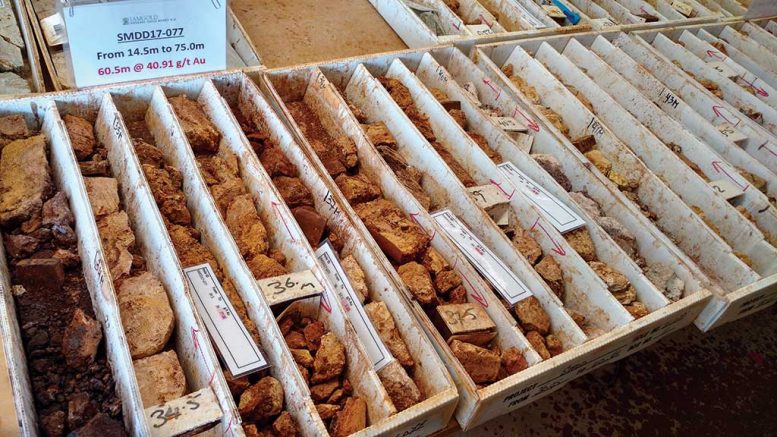Gold exploration and mine development remain leading drivers of mining activity around the world by Canadian-based gold companies. Here is a look at eight junior and senior companies with significant gold developments in 2019.
ALAMOS GOLD
Alamos Gold (TSX: AGI; NYSE: AGI) is a Toronto-headquartered intermediate gold producer with four operating mines in North America: the Young-Davidson and Island Gold underground mines in northern Ontario; and the Mulatos and El Chanate open-pit, heap-leach mines in Mexico’s Sonora state.
The company also has exploration and development projects spread across Mexico, Turkey, Canada and the United States. The company has set aside a global exploration budget for 2019 of $33 million, of which US$19 million will be spent at Island Gold for defining near-mine resources. It has also budgeted US$6 million at Mulatos and Lynn Lake, its feasibility-stage, open-pit gold project in Manitoba.

Alamos Gold’s Island gold mine in northern Ontario. Credit: Alamos Gold.
As of Dec. 31, 2018, the company reported global proven and probable reserves of 9.7 million oz. gold (199 million tonnes grading 1.51 grams gold per tonne) and global measured and indicated resources of 7.2 million oz. gold (202 million tonnes grading 1.11 grams gold).
The company met its production guidance in 2018 for the fourth straight year, producing 505,000 oz. gold at all-in sustaining costs of US$989 per oz. gold. It ended the year debt-free and with a strong balance sheet, including cash and equivalents of US$206 million and US$400 million in an undrawn credit facility.
On March 1, Alamos obtained an operating permit for earthworks on the open-pit area of its Kirazli gold project in Turkey, where the company expects to spend US$75 million in 2019 wrapping up a water reservoir, plus construction and earthworks. The other US$60 million of Kirazli’s total initial capital budget of US$152 million will be spent in 2020, with initial production expected by the end of 2020.
Kirazli could produce over 100,000 oz. gold during its first full year of production at the mine site, with all-in sustaining costs of less than US$400 per ounce. This should bring Alamos’ consolidated production to over 600,000 oz. gold per year.
CONTACT GOLD
Vancouver-based junior Contact Gold (TSXV: C; US-OTC: CGOL) is a gold explorer in Nevada with what it calls a “district-scale property package” on the Carlin trend.
Contact says it is “well capitalized, with a strong treasury” to fund its exploration programs. Its shareholders include Waterton Global Resource Management, Goldcorp and several mining-focused institutional investors.
In March, Contact raised gross proceeds of $2.85 million through a private placement of 9.8 million shares and warrants, with net proceeds earmarked for drilling at Contact’s Pony Creek gold project in Elko County, and for general working capital.

A drill rig at Contact Gold’s Pony Creek gold project in Nevada’s Carlin trend. Credit: Contact Gold.
More recently, Contact reported gold-in-soils extending 580 metres west from the previous drilling discovery at the Pony Spur target on the Pony Creek gold property, with the highest-grade, gold-in-soil sample at 1.18 grams gold per tonne, being returned from a target 480 metres south of Pony Spur in a similar Carlin-type gold setting.
Contact Gold CEO Matt Lennox-King stated: “These new gold discoveries at the traditional Carlin-type gold host are very exciting. To discover our highest-grade gold in soil sample to date from Pony Creek is particularly encouraging given its proximity to Pony Spur, and our other targets on the property. In addition, we are excited to see that our drill intercepts from last year might only have been at the margin of the system, and that there is a substantial footprint of gold extending west and south from Pony Spur.”
EQUINOX GOLD
Ross Beaty-linked Equinox Gold (TSXV: EQX; US-OTC: EQXFF) has committed to produce at its Aurizona gold mine in Brazil in the first quarter of 2019, and is advancing its past-producing Castle Mountain gold mine project in California.
In February, Equinox raised $130 million in the form of a convertible note bought by Mubadala Investment Co., which is owned by the Abu Dhabi government. Proceeds were to be used to refinance part of corporate and project debt, for general and working capital purposes, and toward first-phase construction at Castle Mountain.

The crusher area under construction at Equinox Gold’s Aurizona gold project in northeast Brazil. Credit: Equinox Gold.
In March, Equinox updated the reserve and resource base at Aurizona, which now stands at 19.8 million tonnes grading 1.52 grams gold per tonne for 971,000 contained oz. gold, plus total measured and resources of 12.8 million tonnes at 1.68 grams gold, and another 17 million inferred tonnes at 1.98 grams gold.
The company also updated its reserve numbers at its Mesquite gold mine in southern California, where proven and probable reserves total 54.6 million tonnes at 0.57 gram gold for 1 million contained oz. gold. Measured and indicated resources add 129.9 million tonnes at 0.46 gram gold for 1.9 million oz. gold.
In August 2018, the Vancouver-based junior spun out its copper assets in the Americas into a new company named Solaris Copper, in which it has kept a 40% stake. Solaris’ assets include the wholly owned Warintza copper-molybdenum property in Ecuador and Ricardo early-stage copper-molybdenum property in Chile, and the 60%-owned La Verde advanced-stage copper-silver-gold property in Mexico.
IAMGOLD
Toronto-based Iamgold (TSX: IMG; NYSE: IAG) is an international gold company that last year tallied attributable gold production of 882,000 equivalent oz. gold, including record gold production of 405,000 oz. at Essakane in Burkina Faso, at all-in sustaining costs of US$1,057 per oz. sold.
At year-end 2018, Iamgold’s attributable proven and probable gold reserves were 17.9 million oz. — up 23% from the end of 2017 — while attributable measured and indicated resources (including reserves) were 27.9 million oz. gold. Attributable inferred resources were 8.7 million oz., up 13%, and down 1% from the end of 2017.
On March 19, Iamgold announced it would cut its workforce 32% at its Westwood gold mine in Quebec, because of “planned reductions due to the stage of mine development, as well as realignment reductions due to the previously disclosed production guidance.”
Iamgold’s guidance for Westwood production guidance for 2019 is 100,000 to 120,000 oz. gold, with the workforce reduction “intended as a stabilizing cost control measure.” Meanwhile, the company is developing a revised life-of-mine plan for Westwood, and will update the markets on its progress in the fourth quarter of 2019.
As for its gold-exploration criteria, Iamgold says it will “focus only on projects with a target threshold potential of at least 1 million oz. of mineral resources, capable of reaching 100,000 oz. in annual production.”
Iamgold’s most prominent grassroots exploration projects include: the 1.6 million oz. Boto gold project in Senegal; the Pitangui gold project in Brazil’s Iron Quadrilateral; the Siribaya gold project in Mali; and several joint ventures, such as Monster Lake in Quebec with Toma Gold, and Eastern Borosi in Nicaragua with Calibre Mining.
MAKO MINING
Mako Mining (TSXV: MKO; US-OTC: GRGNF) is the product of a November 2018 merger of Golden Reign Resources and Marlin Gold Mining, whereby Golden Reign acquired all Marlin shares, at a rate of 0.51 Golden Reign share for each Marlin share.
Mako has since focused on Golden Reign’s San Albino gold deposit in northern Nicaragua and Marlin’s producing La Trinidad gold mine in Sinaloa, Mexico. Before the merger, Marlin sold its Commonwealth silver-gold property in Cochise County, Arizona, to Wexford Capital LP, its largest shareholder.
Golden Reign had also restructured its San Albino gold stream agreement with Sailfish Royalty (TSXV: FISH; US-OTC: SROYF), which Marlin spun out in 2017. The agreement includes a 3% net smelter return royalty (NSR) to an area of interest on San Albino, and a 2% NSR on the rest of San Albino, minus the El Jicaro concession.
According to a 2015 preliminary economic assessment, the San Albino deposit has a US$128.6-million, after-tax net present value at a 5% discount rate, and a 47.9% after-tax internal rate of return. It requires a US$13.9-million initial capital expense to produce more than 21,000 equivalent oz. gold per year, for a 31-year mine life at a US$466 all-in sustaining cost.
The project features both open-pit and underground resources. In total it contains 678,000 indicated tonnes grading 7.01 grams gold and 12.5 grams silver for 152,900 oz. gold and 271,800 oz. silver, or 156,100 equivalent oz. gold. It also contains 3.06 million inferred tonnes at 7.99 grams gold and 12.7 grams silver for 787,800 oz. gold and 1.25 million oz. silver, or 806,100 equivalent oz. gold.
In March, Mako CEO and director Kevin Bullock resigned both positions to “pursue another opportunity,” Mako said. Akiba Leisman has become Mako’s interim CEO, and a search is underway for a permanent CEO. Leisman is a director of Mako and was executive chairman and interim CEO of Marlin Gold Mining. Bullock had been CEO at Golden Reign for over three years.
PARA RESOURCES
Vancouver based junior Para Resources (TSXV: PBR; US-OTC: PRSRF) describes itself as an “in-production gold mining company, with projects in Arizona, Colombia and Brazil.”
Para is ramping up to full production at its El Limon mine in Colombia, and just resumed operations and production at its Gold Road mine in Arizona.
Gold Road was discovered in 1900 in Mohave County, 24 km northeast of the Arizona-California-Nevada border, which Para describes as “Arizona’s greatest primary gold producing district.”
Para reported pouring a test 40 oz. doré bar on March 11, and says the “full circuit of mining, crushing, grinding, leaching, electrowinning and smelting has now been fully tested, and is operational,” and that the ramp-up of underground mining continues, with full production expected in the third quarter of 2019, at a goal of 3,000 oz. gold per month.
Ian Harris is Para’s president, while C. Geoffrey Hampson serves as CEO and chairman. Para says it is “unique in that [its] insiders have invested more than $20 million of their own capital, and own approximately 70% of the equity.”
In February, Para raised $5 million in a brokered private placement, with proceeds used to upgrade the small mines at El Limon to fund exploration programs at El Limon and Gold Road, and for general corporate and working capital purposes.
STRATABOUND MINERALS
Stratabound Minerals (TSXV: SB) shifted gears in late 2017 by putting its long-held New Brunswick base metal properties on the back-burner and entering the new Yukon gold rush, as well as relocating its head office from Toronto to Calgary, and hiring R. Kim Taylor as president and CEO.
Stratabound’s new focus is its Golden Culvert gold project in the Upper Hyland Valley in southeastern Yukon, 20 km northwest of Golden Predator Mining’s 3 Aces high-grade gold project.

A drill site at Stratabound Minerals’ Golden Culvert gold property in the Yukon. Credit: Stratabound Minerals.
In its initial exploration program at Golden Culvert in 2018 — which included the first-ever drilling at the property — Stratabound reported “multiple gold-bearing quartz vein and phyllite host rock corridor” intercepted over 400 metres of strike to 200 metres vertical dip in trenching and drilling grading up to 2.53 grams gold per tonne over 33 metres, including 60.1 grams gold over 1 metre.
For 2019, the company’s objective is to confirm gold grade continuity and “target potential sufficient for preparation of a maiden inferred resource estimate by early 2020.”
The company plans to carry out 2,000 metres of diamond drilling this year to extend the area of drilling from 450 metres to at least 1 km of the 24 km strike length at Golden Culvert, comprised of 800 metres of extension drilling and 1,200 metres of infill drilling, including drilling of new targets within a previously defined open-ended 3 km long gold-arsenic soil anomaly.
YAMANA GOLD
This year, Toronto-based Yamana Gold (TSX: YRI; NYSE: AUY) expects to mine 940,000 oz. gold, 10 million oz. silver and 120 million lb. copper, or 1.06 million oz. gold equivalent.
Its latest news came on March 7, with the announcement that Yamana, Glencore (LON: GLEN) and Goldcorp (TSX: G; NYSE: GG) signed an “integration agreement,” whereby Yamana’s Agua Rica project in Argentina would be developed and operated using the infrastructure and facilities of Minera Alumbrera in Catamarca province.
The trio says the integration of Agua Rica and the Alumbrera mine “has significant merit, given the proximity of the assets, and the potential to realize significant synergies by taking full advantage of existing infrastructure associated with the Alumbrera mine.”
Agua Rica hosts a large-scale, long-life copper mineral resource with associated gold, silver and molybdenum. Yamana’s preliminary studies show the potential for a mine life in excess of 25 years at average annual production of 236,000 tonnes (520 million lb.) of copper-equivalent metal, including the contributions of gold, molybdenum, and silver for the first 10 years of operation. This is based on Agua Rica’s proven and probable mineral reserves of 4.5 million tonnes (10 billion lb.) copper and 6.5 million contained oz. gold in 910 million tonnes of ore.
Going forward, the ownership in the integrated assets will be divided between Yamana at 56.3%; Glencore, 25%; and Goldcorp, 18.8%. Yamana will contribute its 100% interest in the Agua Rica project and its 12.5% interest in Alumbrera, while Glencore and Goldcorp will contribute their 50% and 37.5% interests in Alumbrera.






Be the first to comment on "Global Gold Snapshot: Eight companies advancing projects globally"